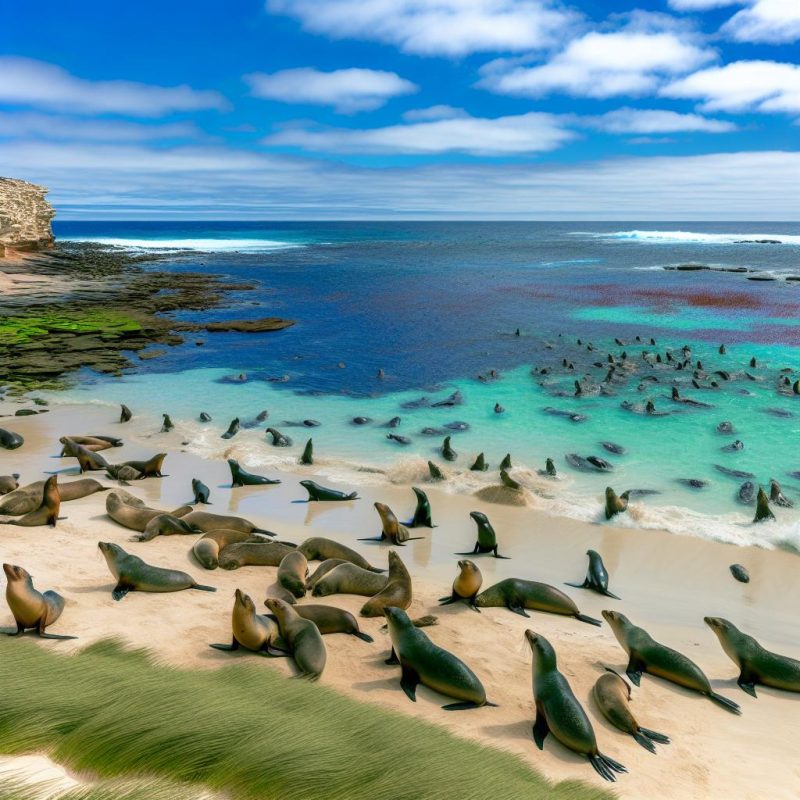Introduction to Seal Colonies
The existence of seal colonies is a fascinating aspect of marine life that underscores the complex social structures of these remarkable creatures. Seals, recognized for their sleek, streamlined bodies, utilize their flipper-like limbs to navigate the waters of their diverse habitats. These gatherings, characterized by their social and practical utility, underline the importance of seal colonies both for the species and the ecosystems they inhabit. Often found on secluded beaches, rocky shores, and ice floes, these environments serve as a refuge from both predators and human activities, ensuring the safety and growth of seal populations.
Types of Seals
The pinniped family, encompassing not only seals but also sea lions and walruses, represents a diverse group of marine mammals. Within this family, seals are categorized into two primary families: Phocidae and Otariidae. The Phocidae family is composed of earless or true seals, including species such as the common harbor seal and the gray seal. These seals are distinguished by their lack of external ear flaps, and they rely on their hind flippers for the propulsion necessary for swimming.
Conversely, the Otariidae family consists of eared seals, which include species like the California sea lion. In contrast to their earless counterparts, eared seals have prominent external ear flaps and employ their front flippers more vigorously for swimming. The physical and behavioral characteristics of these seal families highlight their adaptation to varied marine environments and lifestyle needs.
Habitat and Distribution
Seals are adaptable creatures with habitats spanning both colder and, in some instances, warmer climates. Each species of seal has carved out a niche in specific geographic regions, adjusting to the available environmental conditions. For example, the harp seal is predominantly found in the icy waters of the North Atlantic and Arctic Oceans, perfectly suited to their cold-water adaptation. On the opposite spectrum, monk seals prefer the relatively warmer waters of the Mediterranean and select areas of the North Pacific.
The broad distribution of seal colonies emphasizes the species’ adaptability but also highlights the need for tailored conservation strategies to support each habitat. A deeper dive into the distribution patterns of various seal species can be explored through resources such as the World Wildlife Fund website, which offers a detailed overview of each species’ habitat and distribution.
The Role of Seal Colonies
Seal colonies are fundamental to the overall lifecycle and social structure of seals. These colonies serve a critical role in the reproductive cycle; they are essential breeding grounds where seals engage in mating, give birth, and take care of their young. Beyond their reproductive significance, these colonies are centers for social interaction, where seals communicate and learn vital survival skills essential for their development and sustenance.
The communal nature of seal colonies also acts as a deterrent against predators. The safety in numbers principle applies as large congregations of seals present a formidable presence that may discourage potential predators. This natural defense mechanism further supports the survival of individual seals as well as the collective population within the colony.
Conservation Efforts
Despite their adaptive capabilities, seal populations face significant threats from a multitude of sources. Challenges such as habitat destruction, rapidly changing climates, and historical as well as ongoing hunting practices jeopardize the well-being of these marine mammals. In response, global conservation initiatives have been enacted to help mitigate these threats.
The establishment of protected marine areas offers a haven where seals and other marine life can thrive with minimal human interference. Legal frameworks, such as the Marine Mammal Protection Act in the United States, aim to ensure the preservation of both seals and their habitats. Organizations dedicated to marine conservation, such as the Marine Mammal Commission, work tirelessly to advocate for and implement strategies that safeguard the future of seal populations worldwide.
The continuing efforts of these conservation organizations highlight the importance of preservation and serve as a reminder of the global community’s role in protecting these unique marine species.
Conclusion
The exploration of seal colonies not only offers insight into the social and ecological dynamics of these marine mammals but also emphasizes the essential role they play in their respective ecosystems. As sentinels of the marine environment, seals can influence both the biological and physical characteristics of their habitats. Understanding their behavior, distribution, and the emphasis on conservation provides valuable knowledge contributing to broader marine biodiversity efforts.
Ensuring the survival of seals necessitates a collaborative approach incorporating scientific research, policy development, and community awareness. As we deepen our understanding of seal colonies and commit to protective measures, we contribute to the longevity of a vital component of marine biodiversity, ensuring that future generations can continue to learn from and celebrate these remarkable animals.

